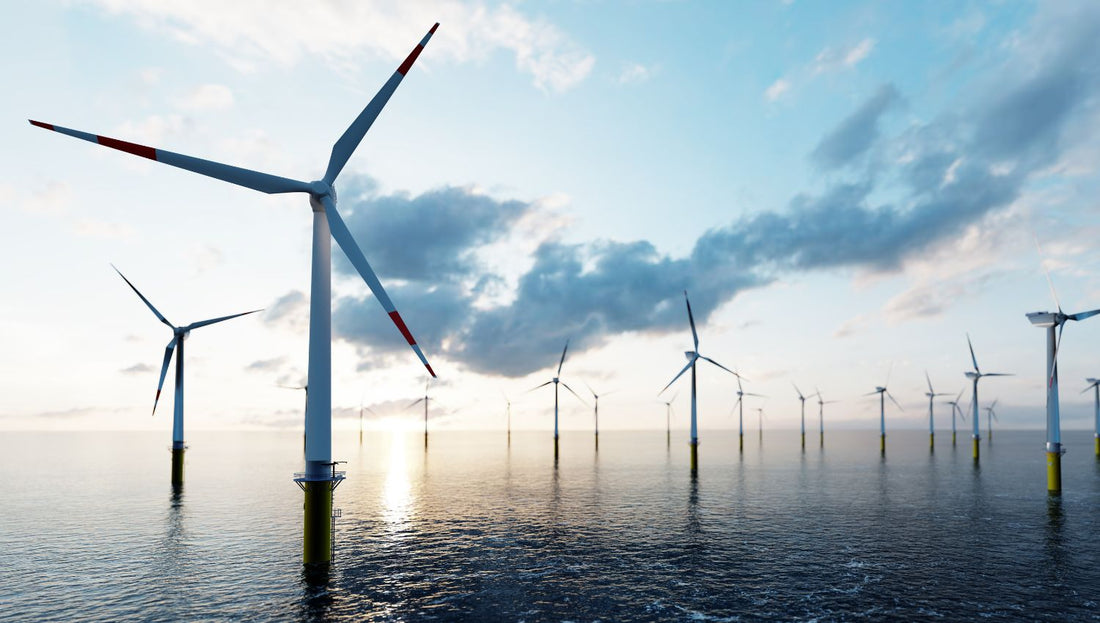
Marine renewable energies
Marine renewable energies are increasingly seen as a sustainable solution to meet the growing energy needs of our planet . Faced with a constant increase in energy demand and the challenges of climate change , our society must imperatively turn to more environmentally friendly energy sources.
In this article, we will explore the different types of marine renewable energy, their advantages and disadvantages, as well as other interesting aspects to consider, such as innovation , research, awareness and social acceptability of these technologies .

The different types of marine renewable energies
Tidal energy
Tidal energy is produced by capturing the kinetic energy of ocean currents . Tidal turbines operate similarly to wind turbines, but are submerged in water to harness the movement of currents.
There are different types of tidal turbines, such as axial turbines, reaction turbines and propeller turbines. Tidal energy has great potential due to the density of water , approximately 830 times greater than that of air, which makes it possible to produce a significant amount of energy even with relatively weak ocean currents.
Tidal energy
Tidal power takes advantage of the difference in height between high and low tides to produce electricity. Dams or tidal plants are built in estuaries or bays to capture this energy.
There are two main types of tidal installations: tidal dams with basins and tidal turbines. The Rance tidal power plant in France, inaugurated in 1966, is an example of a tidal dam with basin and remains one of the largest installations of its type in the world.
Wave energy
Wave energy uses the movement of waves to produce energy. Floating devices, called wave energy converters, are deployed at sea to capture this energy and convert it into electricity . Wave energy conversion technologies are diverse, including oscillating water columns, pivot point systems, pelamis and sea serpents.
The Agucadoura wave power plant in Portugal, inaugurated in 2008, is an example of a wave power project, although it was interrupted in 2009 for technical and financial reasons.
Thermal energy from the oceans
Ocean thermal power (OTE) harnesses the temperature difference between warm surface waters and cold deep waters to produce electricity. This technology typically uses an organic fluid Rankine cycle to convert heat into electrical energy.
Tropical and equatorial regions are particularly suitable for ETO exploitation due to the greater temperature difference between surface and deep waters. Pilot projects, such as the installation of OTEC (Ocean Thermal Energy Conversion) at NELHA (Natural Energy Laboratory of Hawaii Authority), have demonstrated the technical feasibility of this technology, although challenges remain in reducing costs and improving efficiency. 'energetic efficiency.
Benefits of marine renewable energy
Reduction of greenhouse gas emissions
One of the main advantages of marine renewable energy is its low carbon footprint . By replacing fossil energy sources, they help reduce greenhouse gas emissions and fight climate change .
According to the International Energy Agency (IEA), marine energy could help reduce global CO2 emissions by 5.8 gigatons by 2050. This represents a significant part of the efforts necessary to achieve the objectives of the ' Paris Climate Agreement, which aims to limit the increase in global average temperature to 2°C above pre-industrial levels, and ideally to 1.5°C.
Significant energy potential
Oceans cover around 70% of the Earth's surface, offering enormous energy potential. The European Union estimates that wave and tidal energy could meet 10% of EU electricity demand by 2050.
Additionally, some regions of the world, such as Scotland, have particularly high marine energy potential due to their geographic location and ocean conditions . By 2030, the British Isles could generate up to 30% of its electricity from marine energy, particularly through tidal and wave energy.
Complementarity with other renewable energy sources
Marine renewable energies present an interesting complementarity with other renewable energy sources, such as solar and wind energy. Their electricity production is often more predictable and less variable, which can help balance power grids.
For example, tides are predictable years in advance, and waves can provide steady energy production even when wind and sun are intermittent. By combining different renewable energy sources, it is possible to create more resilient and reliable energy systems, able to respond to fluctuations in demand and reduce dependence on fossil fuels.
Disadvantages of marine renewable energy
Development and maintenance costs
Marine renewable energy technologies are still developing and can be expensive to implement and maintain. The costs of installing and maintaining equipment in a marine environment can be high, particularly in harsh weather conditions .
However, as these technologies mature and economies of scale are realized, costs are expected to decline, making marine renewable energy more competitive with conventional energy sources.
Local environmental impacts
Although marine renewable energy has a positive overall impact on the environment, it can have local effects on marine flora and fauna . For example, tidal turbines can disrupt marine habitats and tidal dams can modify coastal ecosystems.
Environmental impact studies are needed to minimize these effects, and mitigation measures, such as designing turbines that are less harmful to wildlife and restoring marine habitats , can be implemented to reduce local environmental impacts.
Limited access to appropriate sites
Suitable sites for the installation of marine renewable energy generation devices are limited due to factors such as water depth , distance from the coast and weather conditions. This can make access and exploitation of these energy resources more difficult. However, technological innovations and advances in research could expand the number of potential sites and make these technologies more accessible.

Other interesting aspects to consider
Innovation and research
The development of marine renewable energies requires significant investments in research and innovation. Governments and international organizations have a key role to play in supporting these initiatives and fostering collaboration between researchers, industry and policy makers.
Funding programs, such as the European framework program Horizon Europe , provide opportunities for the development of research and innovation projects in the field of marine renewable energy.
Awareness and social acceptability
It is essential to raise public awareness of the benefits of marine renewable energies and to prioritize their social acceptability. Local projects and educational initiatives can help engage communities and promote increased support for these technologies.
Public forums, exhibitions and school programs can be used to inform and engage citizens on issues related to marine renewable energy.
Economic potential and job creation
The development of marine renewable energies offers significant economic potential and can contribute to the creation of jobs in the research, engineering, manufacturing and maintenance sectors. According to the Organization for Economic Cooperation and Development ( OECD ), the global marine energy market could reach $53 billion by 2050, creating more than 680,000 jobs.

Conclusion on marine renewable energies
Marine renewable energies represent a sustainable solution to meet the energy needs of our planet. Despite the challenges ahead, their energy potential, their low carbon footprint and their complementarity with other renewable energy sources make them a promising option for the future.
Investing in research, innovation and public awareness is essential to support the development and adoption of these technologies. By combining the efforts of governments, businesses, researchers and citizens, we can harness the potential of marine renewable energy to build a sustainable and resilient energy future, capable of meeting the challenges of climate change and supporting economic growth while preserving our precious planet for future generations.



































